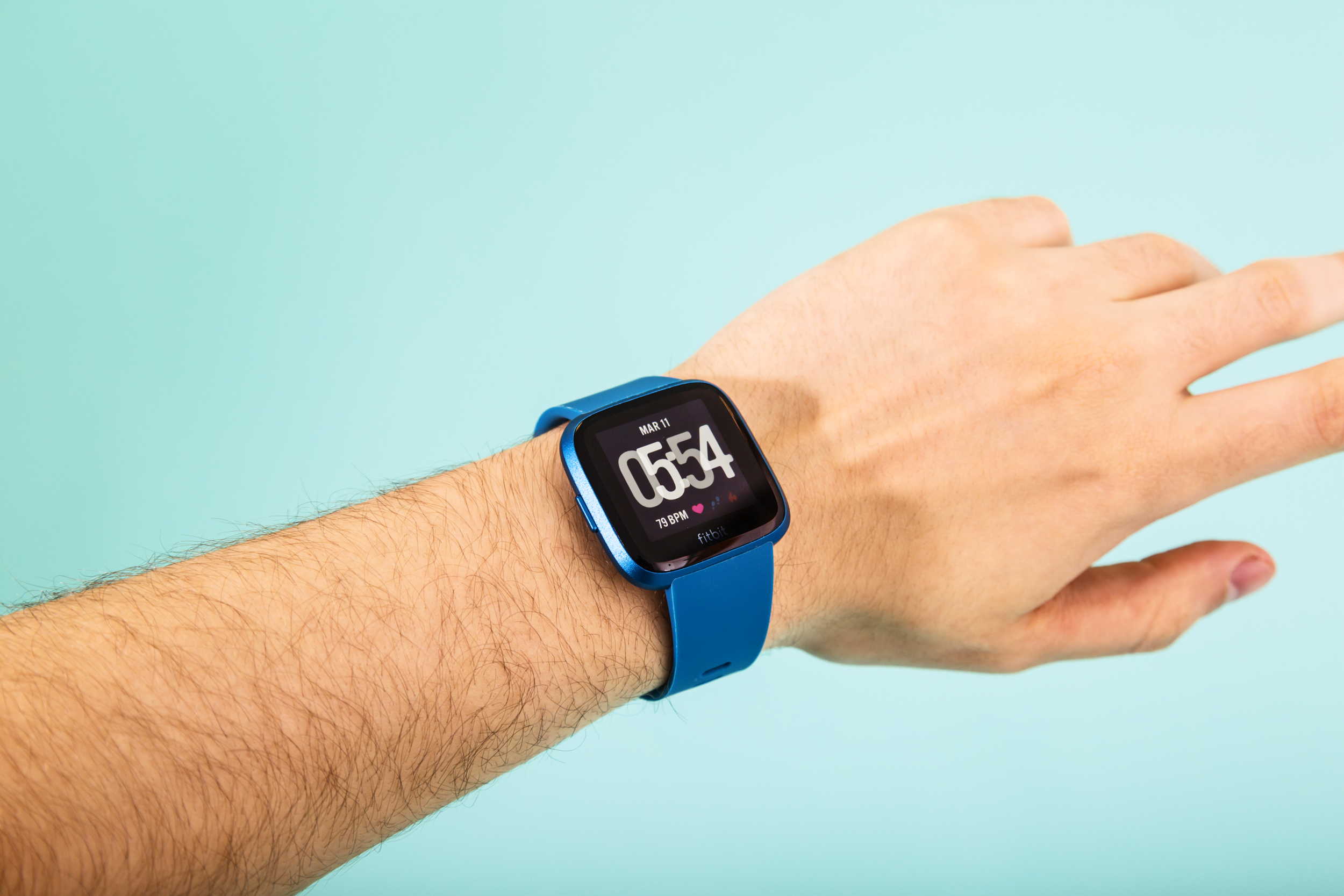- Fitbit’s Versa Lite Edition maintains many of the characteristics that made its predecessor great, at a more affordable price.
- A fitness company at its core, Fitbit has a big advantage in the insights provided from the data it gathers. But rivals like Samsung and Apple are catching up fast.
- The Versa Lite Edition is an affordable and attractive smartwatch, but it may be worth considering its less expensive fitness bands that offer many of the same features.
If you’re anything like me, the first thing you reach for when you wake up in the morning is your phone.
I’ve grown so accustomed to checking my email, my work chat, the news, and social media as soon as I wake up that I breeze through the same five apps without even thinking. But in the past week, I’ve added yet another item to my morning checklist: viewing my sleep data.
For better or worse, the shiny blue watch I’ve been wearing to sleep every night has been giving me a breakdown of how much – and how little- I’ve been sleeping.
I’ve been reviewing Fitbit’s latest smartwatch, the Fitbit Versa Lite Edition, which the company announced last Wednesday and will launch this Friday.
The Versa Lite is exactly what its name implies: a slightly pared-down version of Fitbit's popular Versa watch that lacks some of the original's features - like the ability to show how many flights of stairs you've climbed, count swimming laps, and display workout routines on the wrist - but retains others, like sleep tracking and automatic exercise recognition.
Sleep tracking is far from a new feature for Fitbit and most of its rivals, but it underscores two key areas where the company has a sizable advantage over its products' main competitor, the Apple Watch: sleep tracking, and battery life.
The Fitbit Versa Lite reinforces a lot of the things its predecessor got right, especially when it comes to affordability. At $160, it's roughly $40 cheaper than the original, and less than half the price of an Apple Watch Series 4. It's part of a big effort by Fitbit to bring more users onto its platform as it trails Apple in the global smartwatch market.
But that gap in price manifests in some noticeable ways. And the Versa Lite's somewhat limited functionality can make it difficult to recommend over Fitbit's less expensive bands, like the $150 Charge 3 and $100 Inspire HR.
Here's a closer look at what it has been like to use Fitbit's Versa Lite Edition.
Design and display

For any smartwatch to be useful, it has to look like something you'd want to wear on your wrist all day. Fitbit finally nailed this with the original Versa, and thankfully it didn't make many changes with the Versa Lite Edition.
The new watch comes in different colors, like blue and purple, and has only one button instead of three. But that's where the differences in appearance end.
The screen on the Versa isn't quite square, nor is it round - similar to the Apple Watch - making it ideal for displaying information. But this shape doesn't look quite as natural as the round watch faces of Samsung's new Galaxy Watch Active and Garmin's Vivomove HR.
I never thought I'd say this about a device so tiny, but I found myself missing the Apple Watch's OLED screen after switching to the Fitbit Versa Lite Edition. Watch faces and notifications just pop more on Apple's display, making it easier and more enjoyable to view information at a glance. But I don't think I'm alone when I say I'd gladly sacrifice that perk to save more than $200 on a smartwatch.
Fitness tracking

Of course, fitness is at the heart of what Fitbit does, and the Versa Lite retains many of the health-oriented features of its pricier siblings. That includes tracking steps and calories burned, monitoring your heart rate through the day and night, and pinging you with hourly reminders to meet your step goal.
The Versa also supports more than 15 exercise modes and can automatically track activities such as walking, running, aerobic workouts, elliptical workouts, outdoor biking, swimming, and certain sports if you forget to manually start a workout on the watch. The app's dashboard is full of metrics that provide a snapshot of your fitness and health, from your resting heart rate to your sleeping habits and menstrual-cycle duration.
In my experience, the Versa Lite was impressively responsive in detecting breaks during my workouts. Though I manually told the watch to start a run, it automatically paused the second I stopped to tie my shoe or reach for my phone to switch up my playlist. The Apple Watch frequently detects my brisk walks and runs when I forget to start a workout, but it doesn't usually pause so quickly during a workout the way my Fitbit Versa Lite did.
If you prefer to run outdoors, however, you'll have to take your phone along with you to track your running route and listen to music - the Versa Lite works with your smartphone's GPS to track your location and doesn't include storage for music. And unlike with the standard Versa and Ionic watches, you can't take advantage of the Versa Lite's screen to follow guided workouts on your wrist.
Sleep monitoring

But activity and exercise are only part of the equation when it comes to staying healthy; sleep is a big part too.
Fitbit's Versa Lite can tell you how long you've slept and how much time you've spent in deep sleep versus light sleep and REM sleep. The company says it's also working on a new feature called "Sleep Score" to rate your sleeping habits and help you improve the quality of your sleep.
Similarly, Fitbit's "Cardio Fitness Level" gives you a sense of how in shape you are compared with other people of the same gender in your age range. Features like these that not only gather data but analyze metrics to put them in perspective make Fitbit stand out from other tech firms that don't have roots in health.
The Apple Watch, for example, still doesn't support native sleep tracking, a feature that for years has been table stakes for most dedicated fitness trackers. Sleep plays such an important role in how I feel throughout the day that it's become one of the first things I check when I wake up.
That's possible because of the Fitbit Versa Lite's stellar battery life. After wearing the watch continuously over four days, I still had about 30% battery life left. That's much longer than the Apple Watch Series 4 typically lasts; a full charge will normally get me about two days of use. It's worth noting that battery life will always vary depending on a variety of factors, including how you use the watch and how many notifications you receive.
Fitbit may have some advantages in health tracking, but the competition is quickly heating up. Samsung's new Galaxy Watch Active, roughly $40 more than the Versa Lite, gives users the option to track their blood pressure through a research app it developed with the University of California at San Francisco. Fitbit wearables can't track blood pressure.
The Apple Watch Series 4, though much more expensive than the Versa Lite, is designed to detect hard falls and take an electrocardiogram to detect signs of atrial fibrillation. And Garmin's $200 Vivomove HR tracks many of the same metrics as Fitbit and can detect stress.
Fitbit's watch is certainly cheaper than those, but in some cases it also does less. Fitbit might have to work harder to differentiate its products moving forward.
Smartwatch features

As a smartwatch, the Versa Lite covers most of the basics: It can display calls, texts, calendar alerts, and notifications from certain smartphone apps when within range of your phone, and Android users can respond to texts from the wrist. The watch will also be able to run apps from Fitbit's app store when it launches on Friday. It's sufficient for those who care about staying in the loop without being glued to their phones.
But there are a handful of small but very useful features Fitbit lacks that I found myself missing during my time using the Versa Lite.
I use Siri on the Apple Watch almost daily to set timers when I'm cooking or exercising, and Fitbit's watches have no voice support.
You can also use the Apple Watch to automatically unlock your Mac laptop nearby, and it's similarly possible to unlock your Android phone while wearing a connected WearOS smartwatch within range. When I can't find my iPhone because it's slipped between the couch cushions or is buried at the bottom of my bag, I love being able to ping it from my Apple Watch.
None of these features are deal-breakers, but taken together they highlight the advantages that companies like Apple and Google offer by operating two of the largest smartphone platforms in the world.
Conclusion

Overall, Fitbit's $160 Versa Lite is an affordable and attractive option for those who want an easy-to-use smartwatch that covers all the basics and offers in-depth health tracking.
But given that the Versa Lite can't store music, track your location without your phone, or display guided workouts on the wrist, it may be worth considering the $150 Fitbit Charge 3 or $100 Fitbit Inspire HR. Those devices offer many similar features if you're open to wearing a device that looks more like a fitness band than a smartwatch.
For now, the Versa Lite balances simplicity and affordability with must-have features fairly well. But as companies like Apple and Samsung, which can integrate their watches more closely with the phones and other devices we use each day, get more serious about health tracking, the basics might not be enough.

